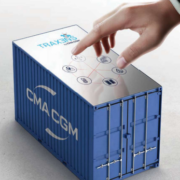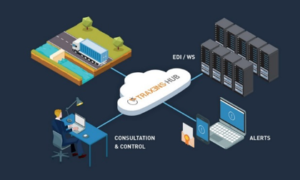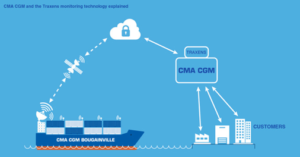Smart Seals: Spotlight on Shellock
Throughout centuries, research and innovation have driven human progress forward. In the maritime sector, blue innovation in particular is key towards the advancement of the industry – in particular against the backdrop of Covid-19 and the damage that it had done to the global economies. This month we caught up with representatives from Shellock, a logistics start-up located in Barcelona, to find out more about the innovative technologies they have been developing.
Shellock is a Logistics Startup, which provides real-time tracking to shipping containers. It combines its product – a service web platform for tracking and its corresponding smart and reusable seal – to make it possible to transparently track the different stages of the shipments throughout the whole supply chain, from origin to destination.
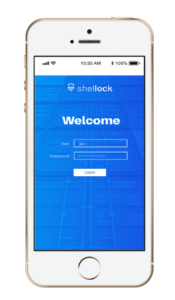
Shellock boasts a user-friendly interface
Shellock also has a huge environmental goal, which consists of eliminating the traditional single-use plastic seals for shipping containers. These plastic seals make 4,000 of plastic waste annually, slowly contributing to the devastation of the marine eco-system. Using Shellocks seals will eliminate the waste of these, as these smart seals are reusable. Moreover, ceasing the trade of the traditional seals can help reduce the emissions of 11 tons of CO2 annually for every 2,000 active Shellocks, further contributing to environmental conservation.

Example of cargo tracking in Shellock
Currently less than 1% of the shipping containers in service are being tracked in real time – presenting a huge opportunity for these kinds of solutions.
The Shellock platform is a web application that can be accessed by mobile devices and normal browsers on desktop or laptop computers. This is the space where the customers are able to see the real-life updates for their shipments. This information is presented in an intuitive and user-friendly dashboard, that details and records every event of the cargo’s trip, making possible to know when the cargo is (or) was transiting by road, sailing by sea, standing by in port or warehouse, etc. Shellock also provides a predictive time of arrival of the cargo and an alert management system, which gives alerts on any incidents such as, robbery, delays and impacts, in real time. Through all of this, the company outfits its customers with the necessary data to allow for better decision making. The format of the data collected is also integrable with others systems used by other actors in the supply chain, such as insurance companies, ports, etc.
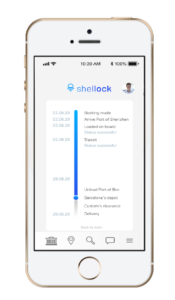
Shellock realt-time tracking of cargo
What is a Shellock?
Shellock is an IoT (Internet of Things) device that starts to emit data to the online platform as soon as it is locked or attached to the door of the container. It is shaped like a padlock, making it familiar and thus easy to use in the market. This reusable IoT device has the autonomy to change network providers all around the globe, in order to keep emitting data and making the real-time visibility possible. It is also equipped with impact and anti-robbery sensors to track any incidents that may occur.

Prototype of a Shellock seal
A little bit of history
In May 2019, the founders met during the first maritime and blue logistics startup weekend, held in Barcelona by Techstars. Without knowing each other beforehand, the group created the team and the idea of Shellock was born after an intense and fun brainstorming session. The concept was so inspiring and enlightening, that it motivated the team in such a way that they forgot they were strangers, but felt that they had known each other for years. This group of entrepreneurs spent three long days during the weekend, shaping the concept, developing the business plan, researching the competitors and preparing a presentation of the final proposal. On the third day, during a 5 minute-pitch, they presented Shellock to a jury compriisng high-rank professionals of the maritime and logistics industry. Shellock placed second in a long list of propsals. Following the award ceremony, a few managers from logistic enterprises approached them, asking the members whether they were planning to make Shellock a reality. And thus Shellock was born.
In January 2020, Shellock partnered with the Universitat de Barcelona and moved to its co-work space known as StartUb! In February, they started the Santander Incubation programme called “Explorer”. In April Shellock was chosen for an acceleration programme for maritime startups, which will be held in Haugesund, Norway and is organized by FLOW Maritime Accelerator. Through this programme the company has secured mentorships, help to approach potential customers and partners to run tests for a product market fit, and will receive help to get in touch with potential investors and other business opportunities. This is going to be a huge opportunity for this promising Startup, and will doubtlessly help reshape the shipping industry and scale-up its products and ventures.
In order to fulfill this dream of going to Norway, Shellock launched a crowdfunding campaign on https://www.indiegogo.com/projects/shellock–2 – / to cover some expenses for the trip to Haugesund and to help produce and optimise the first batch of Shellocks once the programme comes to an end.
Meet the team:
- CEO – Carlos Garces: Marine Engineer and Full Stack Developer, with wide experience in software and hardware testing for Mercedes-Benz.
- CPO – Adolfo Omar Calderon: Nautical Engineer in Navigation and Marine Transportation, with wide international experience working for Tidewater Martine and The Panama Canal.
- CTO – Ferran Guasch: Electronic Engineer, with experience as testing Engineer for Mercedes-Benz and skilled in hardware development.
Do you want to join this movement?
The Shellock team has set up a crowdfunding campaign to help finance their progress. By contributing you won’t be only helping them, you will also join the sustainability movement, helping to reduce the use of plastic and lowering CO2 emissions in one of the biggest industries in the world. Shellock will give away t-shirts, mugs, and some accessories with the company logo, nice collector series Shellocks and will grant some space for sponsors on their website. If you are interested, you can access the campaign through the following link: https://www.indiegogo.com/projects/shellock–2#/




